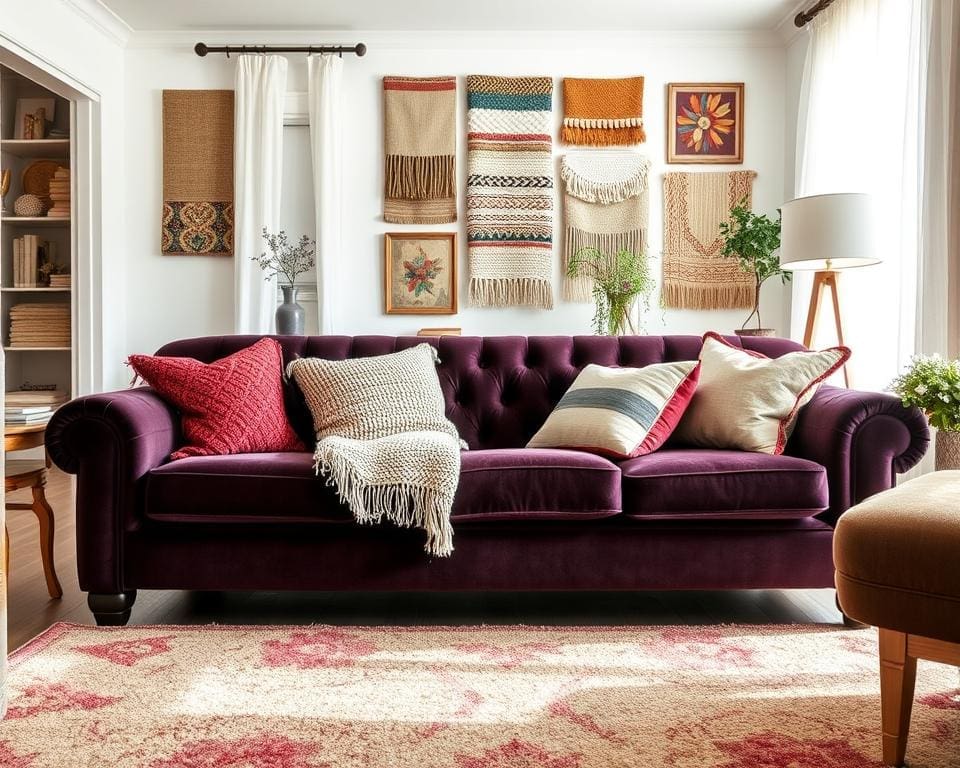Textiles have the remarkable ability to transform a space, breathing life and warmth into even the most mundane of rooms. Understanding how you can use textiles to add texture to a room is essential for anyone looking to enhance their home decor. The right combination of fabrics not only brings visual interest through layers but also satisfies our sensory experience, making interiors feel inviting and comfortable.
From the soft drape of linen to the sumptuous touch of velvet, the variety of home decor textiles available means there is much to explore. By intentionally selecting and employing these materials, you can create a harmonious environment that balances aesthetics with comfort. Stay tuned as we delve deeper into the art of using fabrics for home decor, exploring both their functional and decorative roles in interior design textiles.
Understanding Textile Textures in Room Design
Incorporating textiles is essential for creating a tactile and visually engaging environment in any room. Textile textures in room design dramatically influence the overall ambience, inviting comfort and warmth while showcasing individual style. An adept selection of home decor textiles adds depth and richness, transforming ordinary spaces into extraordinary havens.
The Importance of Texture in Interior Design
Texture serves as a fundamental element in interior design, enhancing the sensory experience and adding visual interest. Combining different surfaces—soft rugs, sleek cushions, or woven throws—can create an inviting atmosphere that draws people in. By introducing various textile textures in room design, one can alter the perception of space, making it feel cozier or more expansive, depending on the desired effect.
Different Types of Textiles to Explore
The array of textiles available allows for endless artistic possibilities. When selecting materials, consider the following categories:
- Natural fibres: Fabrics such as wool, cotton, and hemp not only provide durability but also contribute to an organic appeal.
- Synthetic options: Polyester and nylon offer versatility and often come in a variety of rich colours and textures, catering to modern home decor textiles trends.
- Textured fabrics: Velvet, linen, and boucle present unique surfaces, promoting depth and character in any space.
Exploring these textile types enables individuals to experiment with incorporating textiles for room texture that resonates with their personal style while maintaining functionality and practicality.

How can you use textiles to add texture to a room?
Adding texture to a room transforms the overall atmosphere, elevating it from ordinary to exceptional. By incorporating various textiles, you can create an inviting environment that reflects your personal style. Discover practical techniques for layering fabrics, as well as effective ways to integrate colour and patterns, to enhance your home décor.
Layering Fabrics for Depth and Warmth
Layering different fabric types is one of the most effective ways to add texture to a room. Combining sheer curtains with heavier drapes not only introduces visual complexity but also creates a warm ambiance. Consider using materials like velvet, linen, and cotton in your layering strategy. Each fabric offers unique qualities, such as softness, durability, and elegance.
- Start with a base layer: Use light, airy fabrics for a foundation, providing a sense of openness.
- Add depth: Introduce denser materials like wool or thick cotton to create physical and visual weight.
- Incorporate accessories: Decorative throws and cushions in varying textures can enhance tactile experiences.
Incorporating Colour and Patterns through Textiles
Colour and patterned textiles play a critical role in achieving cohesion within your space. Choosing complementary hues and designs reflects personal style while enhancing the aesthetic of any room. Experiment with a variety of patterns, such as florals, stripes, or geometric shapes, to discover what resonates with your vision.
- Mix and match wisely: Combine different patterns that share a common colour palette to maintain harmony.
- Accessorise thoughtfully: Curtains, cushions, and rugs can serve as the ideal canvas for displaying your chosen patterns.
- Focus on balance: Ensure that busy patterns are balanced with solid colours to avoid overwhelming the space.
Using Fabrics for Home Decor
When embarking on a journey of transforming your space, selecting the right fabrics forms a crucial element in the overall design. Using fabrics for home decor allows for creativity while balancing aesthetics and functionality. Factors such as the room’s purpose, available lighting, and personal style should guide your choices in home decor textiles. Carefully considering these aspects can result in a harmonious environment that reflects your unique taste.
Choosing the Right Fabrics for Your Space
Every room has its own requirements, and the right fabric can significantly enhance its appeal. For high-traffic areas, it may be wise to opt for durable, stain-resistant fabrics. Conversely, soft textiles can create a cosy atmosphere in bedrooms or lounges. Consider the following when making your selection:
- Purpose: Choose functional textiles that meet the primary needs of each room.
- Light: Natural light exposure can affect the fabric’s colour and texture perception.
- Comfort: Soft furnishings should promote relaxation and enjoyment.
- Style: Align your fabric choices with your existing decor scheme.
The Role of Curtains and Drapes in Ambiance
Curtains and drapes serve more than just practical purposes in regulating light and privacy. They dramatically influence the room’s mood and warmth, elevating the overall experience. For instance, blackout curtains create a serene atmosphere in bedrooms, aiding restful sleep. Alternatively, airy sheers allow light to diffuse gently, fostering an inviting living area. Whichever fabric you choose, it plays a pivotal role in incorporating textiles for room texture, enhancing not just beauty but also functionality.
Incorporating Textiles for Room Texture
Transforming a space through the careful selection of soft furnishings can significantly enhance the overall ambiance. The use of various home decor textiles not only improves aesthetic appeal but also adds depth and comfort. Soft furnishings such as cushions, throws, rugs, and bed linens play a pivotal role in incorporating textiles for room texture.
Textiles to Use for Soft Furnishings
The right choice of fabrics for soft furnishings contributes immensely to room texture. Opt for materials such as:
- Cotton – a versatile option known for its breathability and comfort.
- Linen – brings a natural, elegant look while also offering durability.
- Knitted textiles – add a cosy, inviting feel to any space.
Integrating these textiles into your soft furnishings can dramatically enrich the ambience and visual interest of your room.
Textures in Upholstery to Enhance Comfort
Upholstery is another crucial element when considering textiles for room ambiance. Selecting fabrics that combine durability with comfort can elevate furniture arrangements. Consider options such as:
- Leather – provides a sleek appearance and longevity.
- Velvet – adds luxurious texture and warmth.
- High-performance textiles – designed for durability without compromising on style.
Incorporating these textiles can create an inviting and comfortable environment, ensuring your living space feels both functional and stylish.
Room Decoration with Textiles: Tips and Tricks
Transforming your space through the art of room decoration with textiles can be both satisfying and inspiring. Start by strategically placing textiles to create a visually cohesive atmosphere. Mixing fabrics is key; opt for a combination of textures, such as velvets and linens, which can add depth without overwhelming the senses. When arranging your textiles, consider a limited colour palette that resonates throughout the room, ensuring that the fabrics complement rather than clash.
Creating focal points can dramatically enhance the aesthetics of your home. Think about incorporating oversized cushions or a unique fabric wall hanging that draws the eye. Accessories such as throw blankets or decorative pillows not only infuse comfort but also allow you to play with patterns and seasonal colours. Regularly switching out these home decor textiles creates an effortless way to refresh your room for different times of the year.
Finally, don’t overlook the versatility of using fabrics for home decor. Many textiles can adapt beautifully to changing trends while providing a personalised touch to your environment. Investing in quality home decor textiles or sourcing unique pieces from local markets can lead to a space that truly reflects your individuality. Embrace the playful nature of textiles, and watch your home come to life with texture, warmth, and style.









